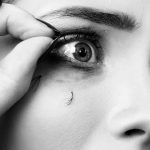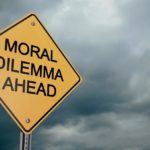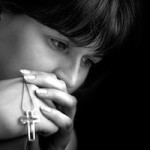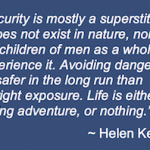Erica Russell, LMFT, LPCC, of the OCD Center of Los Angeles discusses the symptoms and treatment of Postpartum OCD and reflects on her own personal experience with the postpartum anxiety journey as she returns from maternity leave.

My baby is lying so still in his crib. Is he even breathing?
Was that bottle too hot? What if it the milk burns his throat?
Imagine if you just dropped him right now…
Am I following the best sleep plan?… Maybe I need to do some more research!
What if a car hits us while I’m pushing the stroller?
Welcome to my postpartum brain! Being away on maternity leave for the past four months has given me an amazing opportunity to bond with my new baby boy, but like most moms and dads out there, it has also brought on a spike in anxiety. The statements above are examples of obsessive thoughts, which refers to any intrusive and distressing thoughts, images, or impulses that repeatedly enter our mind. These kinds of thoughts feel unwelcome and difficult to control. Research has shown that about 90% of new mothers (and fathers!) experience obsessive thoughts about their baby following their birth, and unfortunately, being an anxiety disorder therapist has not made me immune (bummer, right?!). The postpartum period, which can be defined as the first twelve months after a baby is delivered, presents a perfect storm for anxiety to grow. The combination of shifting hormones, sleep deprivation, difficulty with feeding, cultural/ social expectations, and the huge responsibility of caring for a newborn are just some of the factors that contribute to this being a more tumultuous period for parents. While experiencing some degree of anxiety and obsessive thoughts postpartum is very normal, sometimes the level of distress and impairment in functioning associated with these symptoms can signify something more.
What is Postpartum OCD?
Postpartum OCD affects an estimated 3-5% of new mothers and some new fathers. In the DSM 5, Postpartum OCD is not a separate diagnosis, but rather, a sub-classification of Obsessive Compulsive Disorder in which symptoms begin or worsen shortly after the birth of a baby and obsessions largely center on the fear of accidentally or purposely harming the newborn. If you have OCD prior to the birth of a baby, there is a greater risk of developing increased symptoms during the postpartum period. However, postpartum OCD can also appear in individuals with no prior history of OCD symptoms and typically has a more rapid onset.
Symptoms of Postpartum OCD:
Similar to other subcategories of OCD, Postpartum OCD is characterized by the presence of obsessions and compulsions.
Examples of common obsessions in Postpartum OCD include:
-Unwanted thoughts or images of accidentally harming the baby by dropping, burning, or handling too roughly
-Intrusive thoughts or images of intentionally harming the baby by stabbing, throwing, suffocating, or drowning
-Disturbing thoughts of sexually abusing the baby
-Persistent thoughts or images of the baby dying in their sleep
-Fears of accidentally harming the baby by exposure to medications, germs, chemicals, or certain foods
-Intense fixation on non-fatal decisions (wanting to be certain that your sleep or feeding plan is “right” or that the “best” baby products are selected)
-Thoughts of making a wrong decision that leads to a serious or fatal outcome (vaccinations, introducing new foods, use of anti-depressants)
For the parent struggling with Postpartum OCD, the presence of these obsessive thoughts is often judged as evidence that the fears are more likely to come true or that they carry some greater meaning. A new parent may experience scary thoughts related to harm and jump to the conclusion that simply having the thoughts makes them a bad person, or more likely to act on the thoughts by actually harming their baby. While this interpretation is of course terrifying for the parent, it is important to state here that it is NOT correct. The chance of a person acting on an intrusive thought is extremely low, and having these thoughts is NOT a sign of underlying violent tendencies. As stated above, approximately 90% of new mothers and fathers may experience intrusive thoughts following the birth of their baby, and we know that 90% of parents are not engaging in harmful behaviors towards their babies. However, because there is no way to 100% prove that a scary thought will not come true, a person with Postpartum OCD will likely respond by attempting to control their thoughts by engaging in compulsive behavior.
Examples of common compulsions in Postpartum OCD include:
-Excessively/ repeatedly checking on the baby during their sleep
-Avoidance of preparing or feeding bottles/ solid foods
-Hiding or avoiding sharp objects such as knives or scissors
-Repeatedly asking family members, friends, or doctors for reassurance
-Avoidance of changing diapers or bathing the baby due to fears of sexual abuse
-Monitoring your thoughts or emotions for signs of rage or violence
-Monitoring your body for perceived sexual arousal
-Mentally reviewing daily tasks to check that one has not accidentally harmed the baby or been careless in some way
-Repeatedly dumping or re-making bottles/ solid foods due to fears of contamination or poisoning
-Excessive research of baby related topics (health, sleep, feeding) or baby products
-Efforts to suppress or “undo” thoughts that you judge to be “inappropriate” or “dangerous”
-Avoidance of certain food or products due to fear of harming the baby (even though this avoidance has not been medically advised)
From the examples above, you may notice that avoidance, reassurance seeking, and checking behavior are some of the more predominant compulsions seen in Postpartum OCD. For a new parent, avoidance of holding, feeding, or bathing their own baby due to intense fears of harm can be heartbreaking, and this avoidance can make it difficult to function as a caregiver. Although they may be more subtle and harder to distinguish, mental compulsions such as mentally checking for “bad” thoughts, analyzing what it means that “bad” thoughts are present, and efforts to suppress or neutralize those thoughts, can be equally distressing and harmful. While the parent may engage in these mental compulsions in an effort to better understand and control the scary thoughts they are experiencing, this pattern of being overly attentive to thoughts, over-valuing their importance, and overly responding to their content backfires, creating a cycle where the more a thought is judged as “bad” or mentally pushed away, the more that thought persistently pops up. It is not the presence of these thoughts that is the problem, but the meaning and responses we apply to them.
Treatment for Postpartum OCD
Fortunately, Postpartum OCD can be effectively treated using the same evidence based interventions used with other OCD presentations. Cognitive behavioral therapy with an emphasis on Exposure and Response Prevention is considered the gold standard in treatment. When treating Postpartum OCD, I typically begin by educating my clients about OCD and their unique obsessive compulsive cycle. Oftentimes, significant progress can be made simply by having this education and building awareness of how their well-intentioned efforts to control their thoughts may actually be backfiring and feeding the OCD cycle. The next step in treatment is building cognitive skills for responding to obsessive thoughts in a new way. Mindfulness based CBT teaches the client to give less attention and importance to the scary thoughts that arise, to treat thoughts of potential harm as expected, inevitable, and annoying, rather than serious, meaningful, and dangerous. One of my favorite mindfulness based exercises is to practice responding to obsessive thoughts with a dismissive, or even sarcastic tone. This could sound like “Oh, there’s one of my scary thoughts again. I expected that. I get those a lot”, or “I don’t have time for you right now OCD”, or “Oh hi OCD! So nice of you to show up!” Ultimately, the goal of cognitive work is to shift away from trying to suppress, analyze or control obsessive thoughts, and to move towards accepting and allowing these thoughts to exist without giving them as much meaning— to make space for the scary thoughts, rather than trying to eliminate them.
In terms of behavioral interventions, we’ll often start by establishing some response prevention guidelines to begin decreasing the compulsions in which a client has been engaging. Examples of these guidelines might be: setting limits on reassurance questions or time spent researching online, setting limits on the number of times a parent checks on their baby or re-makes a bottle, or mindfully noting and accepting an intrusive thought when it pops up, rather than taking the thought as a cue to go into mental analysis mode. Another early behavioral intervention may be enlisting loved ones in an effort to reduce accommodation. For example, if a mother’s spouse has been accommodating her obsessions by doing all of the bathing duties for their baby, we might begin getting the mother involved in the bathing process again. Or if a father has been asking his spouse to supervise every time he makes a bottle to obtain reassurance, we might try cutting that supervision out.
Once these foundational steps are in place, I will usually begin to ease my clients into exposure and response prevention work. The process of ERP involves intentionally exposing a client to triggering thoughts, images, or situations, while preventing their typical response of utilizing compulsions to neutralize the anxiety these triggers provoke. While initialing intimidating, this well-researched process has multiple benefits. When we approach an anxiety trigger and choose to move through it rather than avoiding, suppressing, or neutralizing it in some way, a natural desensitization to that trigger often occurs and the associated anxiety begins to decrease all by itself. More importantly, we learn that we are capable of tolerating the anxiety, doubt, and uncertainty that has been avoided for so long. Exposure work does not need to be outrageous or extreme to be effective. Quite the opposite, I typically find it most beneficial to collaborate with clients in creating an exposure hierarchy in which we start by gradually approaching more mildly triggering situations, and slowly build our way up to bigger challenges. Exposure can also feel more approachable when we select exposures that align closely with our values. For example, for a mother experiencing obsessive thoughts of intentionally harming her baby and associated compulsions of avoiding holding her baby, gradually working towards touching and holding her baby with less and less supervision would be a practical exposure that helps her to move towards an experience she would highly value— being able to once again enjoy snuggling with her baby. While the exact exposures selected are always tailored specifically for each client based on their OCD cycle, common exposures might include: writing, listening to, reading, or speaking triggering words and statements, gradually engaging in previously avoided acts of caring for the baby, such as bathing, diapering, feeding, or holding, using imaginal exposure, a technique in which a short story is written to expose oneself to a situation that cannot be experienced through traditional ERP, or holding/ touching feared items (knives, certain foods, medications, cleaning products) that have previously been avoided.
Beyond Postpartum OCD
While the information above has been intended to give a closer look into Postpartum OCD symptoms and treatment, it’s important to note that Postpartum OCD is not the only anxiety presentation that can arise in the pregnancy/ postpartum period. Perinatal OCD would be the term used to describe a sudden appearance or increase in OCD symptoms during pregnancy. And similar to Perinatal/ Postpartum OCD, it can also be common for other anxiety disorders to first present themselves or worsen during the perinatal/ postpartum phases. For example, Panic Disorder, Generalized Anxiety Disorder, Health Anxiety, and Social Phobia may also appear or escalate during this sensitive timeframe. And even if criteria for an anxiety disorder or OCD diagnosis are not met, it can still be immensely helpful to seek out support through family, friends, or therapy during the perinatal/ postpartum stage to find ways to better manage distress and more fully enjoy this stage of life. Personally, I find it incredibly beneficial to talk with family and friends about the stress associated with taking care of my baby and to engage in my own personal therapy to proactively work through any obsessive thoughts and patterns as they arise. While society may push the message that pregnancy and the newborn phase should involve “loving every moment” or “soaking up all those newborn cuddles”, it can also be a beast! This phase feels hard because it is hard, and getting support can be key in navigating this beautiful, but difficult time. Making space for the scary thoughts can help us make space for more joy.
•Erica Russell, LMFT, LPCC, is a licensed psychotherapist at the OCD Center of Los Angeles, a private, outpatient clinic specializing in Cognitive-Behavioral Therapy (CBT) for the treatment of Obsessive-Compulsive Disorder (OCD) and related anxiety based conditions. In addition to individual therapy, the center offers eight weekly therapy groups, as well as online therapy, telephone therapy, and intensive outpatient treatment. To contact the OCD Center of Los Angeles, click here.




























































4 Comments
Currently 8 months postpartum. Before I got pregnant, my OCD was managed extremely well. After my daughter was born, I entered the most euphoric period of my entire life. Month after month, I woke up calm and happy, despite newborn difficulties. I didn’t have to work at managing my OCD anymore–after giving birth, it seemed like my OCD disappeared! 8 months later, my baby is starting to wean. This means prolactin and oxytocin levels are starting to drop and my estrogen is going to return to normal. I am starting to feel my anxiety return, and I’ve needed to remind myself of all the strategies that have worked for me in the past. I’d heard a lot about postpartum anxiety and OCD, but until recently I’d never heard of post-weaning anxiety.
Hi Jaimie, thank you for sharing your experience and bringing more awareness to this topic! You’re right: post-weaning anxiety is rarely discussed and has very little research, but it is another common way that postpartum anxiety can present given the rapid shift in hormone levels. One of my favorite things about CBT is that when a new anxiety trigger arises, there’s no need to build a whole new toolbox of strategies– the cognitive and behavioral skills that have been practiced in the past can be adapted and applied. Hopefully the combination of having awareness of post-weaning anxiety and already having a collection of well-rehearsed strategies will help you in weathering the storm as your body adjusts through this weaning phase.
Great read! Does the OCD Center of LA offer a perinatal/postpartum OCD group class? I’ve already taken the weekly general OCD class, which was great but wondering if there is something more specific for birth.
Thank you for your comment and apologies for the delay in response! Unfortunately OCD Center of Los Angeles does not offer a perinatal/ postpartum OCD group at this time, but it’s a great idea and something we might consider if enough callers were expressing an interest.